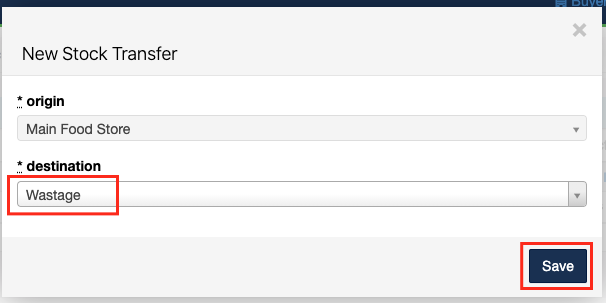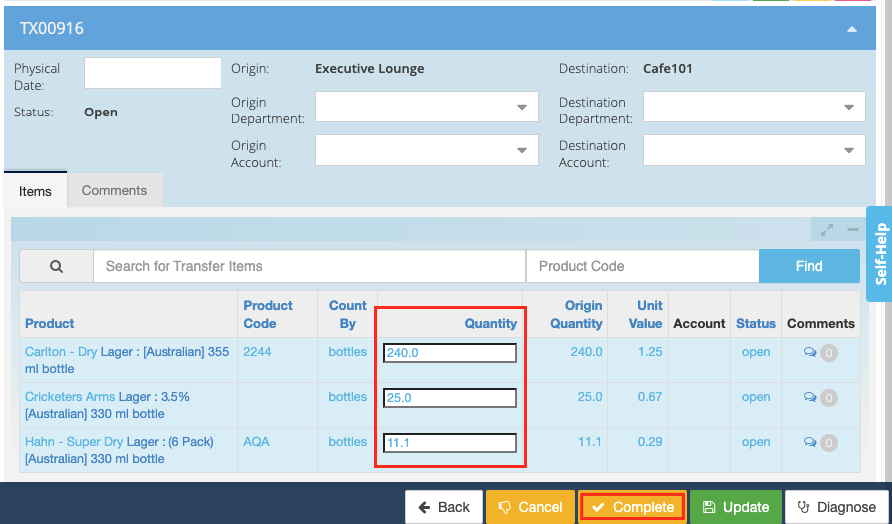In this section, we will show you how to finalise your month end process and complete your stock takes.
We have broken down month end into the following parts:
Part 1 - Pre-Month End Preparation
Part 2 - Start Month End Stock Take
Part 3 - Enter Counts
Part 4 - Zero Out Variances
Part 5 - Close Month End Stock Take
Part 1 - Pre-Month End Preparation
Before starting the Month End Process, ensure that the following tasks have been completed:
1. All Purchase Orders for this month have been received into an inventory location.
2. All Stock Requisitions & Transfers have been completed for this month.
! Best Practice Tips
We recommend the following best practice checks to ensure all transactions are completed:
-
Run an Accrual Snapshot for a few days before the last month-end date to the current month's end date. Filter that snapshot by the account code you receive to inventory, making sure all applicable invoices are processed and those that should be received into inventory have in fact been received to inventory. There is a 'Received to Inventory column' in the Accrual snapshot to help you determine if the invoice was received.
-
Review the [Inventory] [Transfers] section. If there are outstanding transfers that need to be completed for the current period, complete them now. Leave other transfers, if they are for the next period.

Part 2 - Start Month End Stock Take
3. Go to [Inventory] [Stock Taking] and click [Start All]. Alternatively, you can also start a Stock Take per Stock Location.
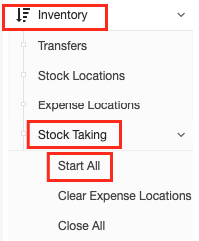
Part 3 - Enter Counts
4. Click [Count Not Started] to go into the Stock Location and to enter the counts for your Stock Take.

5. In each Stock Location, enter the counts line by line, ensuring to enter '0' if there is no physical stock in that location.
Alternatively, to import via a spreadsheet, select [Export], enter the counts in the csv. file and [Import] the csv. file. All products must have a count, input '0' if there is no stock.
Once all counts have been entered, click the [Done] button to save.
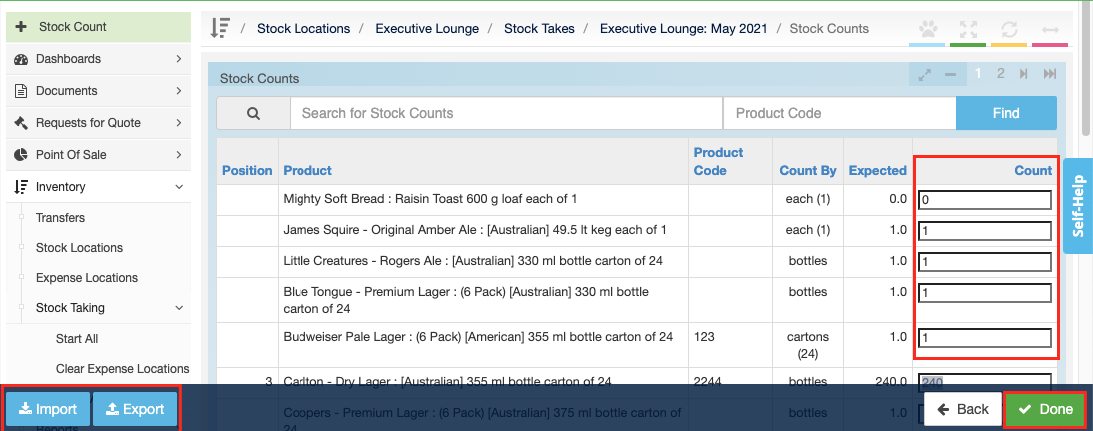
Note - If you require a print out of products from each Stock Location, you can do so by going to [Inventory] [Reports] [Stock Take List]. You can choose to export this as PDF format.
6. Once the count is complete for all locations, there will be some locations with a 'variance'.

Part 4 - Zero Out Variances
7. At this point, run the Variation Report for each location, which is located in [Inventory] [Report] [Stock Variation].
Ensure you enter the location you want in the 'Search by Location' field, if you leave this field blank you will get a report for all stock locations at once.

Note - Running this report will allow you to see the variances at each location. It is the best practice to review these numbers and do spot checks. We recommend looking at least at the large variances, to ensure the counts were done correctly and if the numbers were entered correctly during the Stock Count input.
You will use the Stock Variation report from each Stock Location in step 8.
8. In order to close a Stock Take, the variance value needs to be $0.00. To get here, users will be presented with two scenarios:
-
Scenario A - The location should not have a variance, i.e. The Beverage Store. This may be as a result of breakage or loss of stock. This is when the variance needs to be issued out to a wastage location.
-
Scenario B - The variance is actually the Cost of Goods Sold. This needs to be issued out as a 'variation'.
Note - Once the Main Beverage Store is zeroed out, and you are satisfied with the variance for the other locations, run the Stock Variation Report as a csv. and PDF, as you will need to send this report to your Finance Team.

Click on the blue 'number' in the variance column.

8 (a). For Scenario A above, click [+ Stock Transfer].

Choose the destination you intend to transfer these items to and click [Save].
The system will automatically autofill the amounts required to zero out the 'Variance'. If the product doesn’t belong to this location, put a 0.0 in the 'Quantity' column, then click [Complete]. Repeat these steps if a Stock Transfer needs to be done for other locations.
8 (b). For Scenario B, click [+Stock Variance].
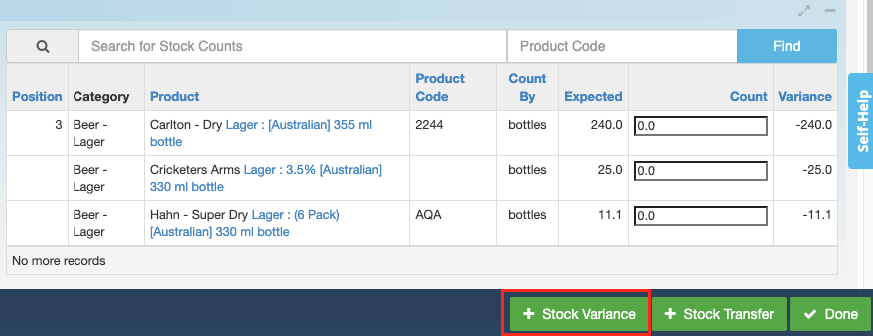
Select destination [Variances] and click [Save].
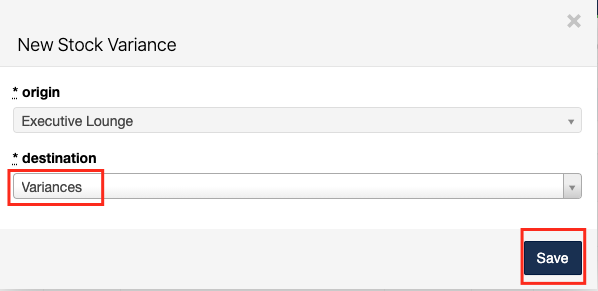
Select [Complete], to transfer the variances.

9. Repeat the above steps for all Stock Locations.
Part 5 - Close Month End Stock Take
Once all the 'Variations' are $0.00, your locations will now be highlighted in green, and you are ready to close your Stock takes.

10. From [Inventory] [Reports], run following reports:
Note - Before closing the stock take, we recommend running the Stock Variation Reports again per Stock and Expense Location as an audit trail, to show stock movement between the locations throughout the Stock Take.
The Stock Valuation - Summary & Stock Valuation - Detail are particularly important for Expense Locations, as once you clear Expense Locations, you cannot raise any further reports for those specific transfers.
11. Go to [Inventory] > [Stock Taking] > [Clear Expense Locations].
This clears all the Expense Locations, where direct expenses are sent to, such as your Sales & Marketing expense location.
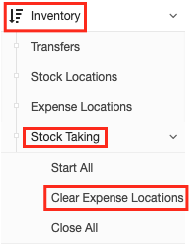
12. Once you have run the Stock Variation Report again, go to [Inventory] > [Stock Taking] and [Close All].
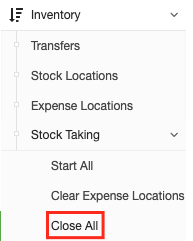
13. From [Inventory] [Reports] we recommend you run the following reports:
-
Cost of Goods Sold (export as .csv and .pdf)
-
Stock Valuation – Detail (export as .csv and .pdf)
-
Stock Valuation – Summary (export as .csv and .pdf)
Send the above three reports along with the Stock Variation Reports from the steps above to your Finance Team, and you are done!
